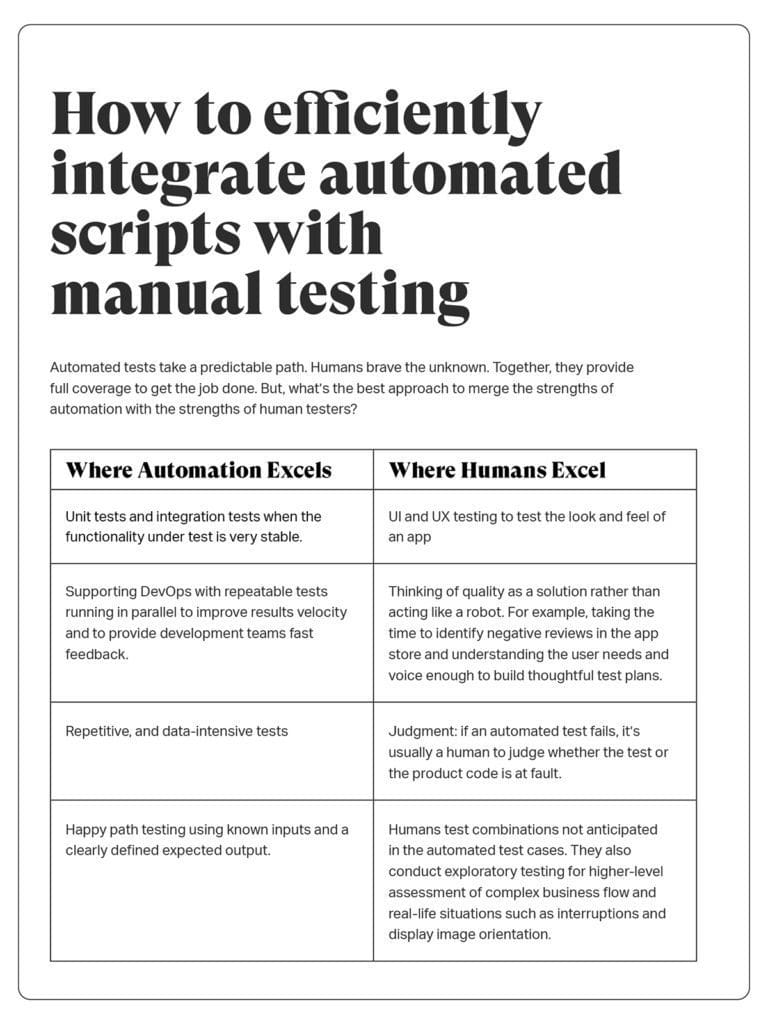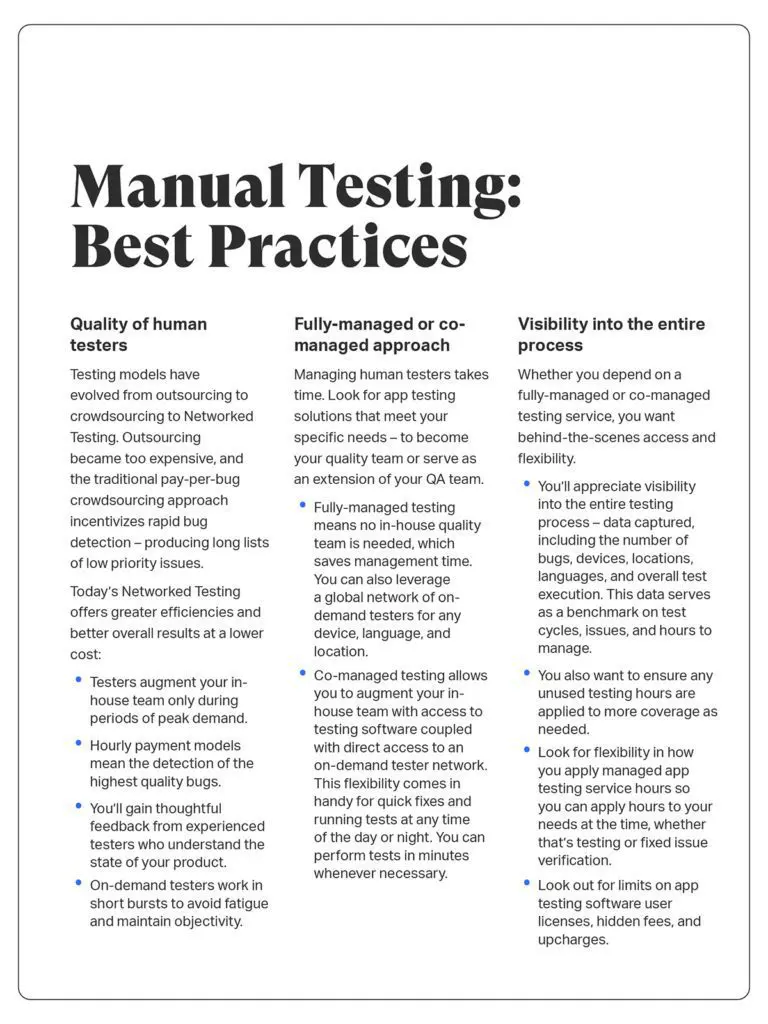Why manual testing is here to stay: a Q&A with Testlio Engagement Manager, Oksana Lang

With the advent of AI, machine learning and automation’s rise in popularity, the “death of manual testing” has been, for many years, a much-discussed topic in the QA industry. But despite the controversy, the reality is that you simply cannot automate everything – some things still require good old fashioned human observation and creativity. And alongside the advancement of technology and traditional testing requirements, expert manual testing maintains a vital place in the quality assurance process. Not only as a valuable complement to automated testing but also as a cornerstone of the customer experience.
In her recent TestingStage conference talk, Testlio Quality Assurance Engagement Manager, Oksana Lang, spoke about why manual testing is still very much alive. We asked her to share some of her insights and key takeaways.
About Oksana
With over 12 years of experience as a QA software testing professional, Oksana has an impressive international background working for several global-scale companies. More specifically, she has extensive knowledge in web and mobile application testing (including client-server application testing, functional and non-functional testing, writing automated tests, etc.) along with strong project management skills. Being extremely passionate about software quality, Oksana truly enjoys the ability to positively impact consumer apps worldwide.

Why is manual testing still important and what does the future hold?
Speaking from my experience, I can boldly claim that manual testing is still important and will remain so for a very long while – it is the only way to gather early feedback from the user. In today’s saturated market, where thousands of applications are released every day, only early user feedback can help inform the development team and see whether the product resonates with real-life users:
- Is the application design intuitive?
- Is the application easy to master?
- What is the user’s first impression?
- Will the user want to launch the application again?
Companies that do not integrate manual testing into their testing process essentially leave the job to their actual end-users – who are quick to leave negative reviews and stop using the app altogether if it doesn’t perform well. Thus, manual testing is a critical step before any public release.
For example, a Testlio client in the communication industry integrates a mix of automated and manual testing in-house to first verify that there are no blocking issues. After that, they ask Testlio testers to swarm the application and test it (both new features and regression testing) on a wider range of devices – the client makes a release decision based on the test runs’ results. Also, they collect our testers’ subjective feedback about the release and take these suggestions into consideration for future features development.
In which scenarios should manual testing be prioritized over automated testing?

Generally speaking, it makes sense to automate unit, integration, repetitive, and data-intensive tests. However, one thing to remember is that automation is a time-consuming investment – if not done properly, it can slow down the release process and take up additional development time to debug automated testing infrastructure issues. Therefore, it’s more effective to use humans early in the development phase because the product is likely undergoing a lot of changes. Here, a quick round of manual testing done by beta testers, in-house dog fooders, or a burstable team of external expert testers, is more likely to reveal important issues faster – plus the time saved building automation scripts can be used to fix uncovered issues instead. Once the release is deployed, and the need for speed has decreased, the development team can start adding automation. Most developments for successful projects follow an iterative model – incremental improvements every 2 weeks for example. In those 2 weeks, only a small percentage of the overall product is changed, the rest remains the same. Ideally, an automated suite would verify that the unchanged parts still function correctly, while allowing the humans to concentrate on the suitability, usability, and functionality of the new content.
This type of combined model works really well for one of our clients in the travel industry. First, the client releases a new version to production, then performs the Testlio Run cycle and fixes any critical issues. After that, the Testlio team verifies the fixes and the client deploys the web application to production.
Related: Best use cases for automated and manual testing
How do global companies utilize remote on-demand manual testing?

When Testlio is fully integrated into the release process, testing hooks seamlessly into DevOps processes at the end of the dev sprint. For example, developers release the build to staging on Friday night, then Testlio testers leap into action over the weekend to analyze and prioritize feedback, enabling developers and Product Owners to make a decision on Monday morning to either release the build to production or fix a set of issues before public release.
As an example, one of Testlio’s clients in the customer loyalty sector uses our networked testing approach with their development cycles. They share the build with the Testlio team on Friday night for testing over the weekend – expert testers work in small concentrated teams, across multiple devices, time zones, locations, etc. in short 2-3 hours bursts to swarm the testing surface and uncover software bugs. Then on Monday, based on the testing report, the client is able to decide whether to send the build to its stakeholders for further approval or wait and fix the identified issues.
Another benefit of having a team of on-demand testers, companies only have to pay for the testing when needed. For instance, one of our clients needs a large set of testing, all on different devices, but they release just once per month. With on-demand testers, they are able to get that device coverage without having to invest in a large hardware lab and a group of testers on standby.
Are there any particular trends you see in the QA industry?
Speed-to-market matters more than ever. I see companies moving more and more towards faster release cycles – something Testlio’s benchmark research on app release frequency confirms as well. This was especially evident following the recent coronavirus pandemic as the crisis created the need for a shift in business tactics. Many companies had to move online as fast as possible in order to adapt to changing needs, while still providing compelling customer experiences.
To illustrate that, one of Testlio’s clients in the educational sector saw its demand for online educational resources increase exponentially during the pandemic. The client needed to quickly adapt to this explosive change by extending its app’s possibilities, simplifying the payment flow, and enabling even better user experiences. Thanks to its wide pool of quality assurance testers and extensive device coverage, Testlio was able to quickly test all the new features and release them to production in record time.

As the originator of networked testing, Testlio powers burstable software testing in any location, on any device, in any language. Request your free demo today to learn more.
